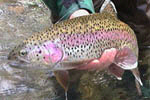|
In
early June of 2002, I made a three-day visit to Yellow Creek
in Bedford County, PA, with three York County fly fishing
friends (Yes, this Retired Old Fart does have a few
friends). Yellow Creek is a "limestoner" with trout in
both quantity and quality, and some prolific hatches not the least
of which is the Green Drake. Yellow Creek has a Delayed Harvest (DH)
Fly-Fishing Only stretch of water, but the entire stream holds nice
fish all year round.
The first morning we were fishing
the bottom of the DH area. Early on Peter Frailey’s Hare & Herl Bugger
fished on a deep swing was pounding fish but as the sun rose and
burned off the early morning haze things really slowed
down.
Searching through my fly boxes (I
carry too many, as most of us do), I spied a large, very buggy,
cream colored nymph that had taken some big browns on Spruce Creek
(Centre County, PA) about four years ago. My brother-in-law, the
late Russ Mowry from Latrobe, had been a member of Spruce Creek Rod
and Gun Club. He had given me a sample and told me to be sure to
have some when I met him on Spruce Creek, as the fly was especially
good just prior to, during, and just after the Green Drake hatch. It
had accounted for a number of fish then, included a fat brown just
over 22".
I had not fished the fly since
that last Spruce Creek trip but figured "what the heck", Russ said
it worked, it had produced then, so why not give it a
try.
Working out some line, I made a
cast toward the far bank, mended the line to get a deep drift,
turned my head to say something to one of my buddies, and almost
missed seeing the strike indicator jump about a foot. With strictly
a reflex reaction, I raised the tip and was fast to a decent fish
and quickly brought to hand a rainbow of about 14". Two casts later,
a repeat of the indicator really jumping but this time a fat
brown.
During the next hour and a half,
12 to 15 browns and bows were brought to hand with the largest about
17". I broke off another fish, broke off on a submerged rock or log,
lost a fly to an overly aggressive cast to the far bank that landed
in a branch about 6’ above the surface, and then snagged up on
something solid on the bottom. Neither shifting position, popping
the line, nor aggressive pulls worked, and then the tippet
parted.
I went through all my fly boxes
and "there weren’t no more." Bemoaning my fate, I tried many other
nymphs but to no avail. Finally, fish began to work on the surface
and I rigged up to fish another of Russ’ creations, the spent wing
parachute Pine Creek Special that had given me some fantastic dry
fly fishing on Yellow Creek the previous year. But, that is
another
story. (My fly box now has an ample supply of Green Drake
nymphs).
--Fred Bridge
|



